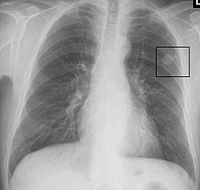
Photo from wikipedia
Purpose To clarify the clinical and computed tomography (CT) indicators in distinguishing pulmonary nodules caused by fungal infection from lung cancers. Methods From January 2013 to April 2022, 68 patients… Click to show full abstract
Purpose To clarify the clinical and computed tomography (CT) indicators in distinguishing pulmonary nodules caused by fungal infection from lung cancers. Methods From January 2013 to April 2022, 68 patients with solitary fungal nodules (64 were solid and 4 were mixed ground-glass nodules) and 140 cases with solid cancerous nodules with similar size were enrolled. Their clinical characteristics and CT manifestations of the solid nodules were summarized and compared, respectively. Results Compared with patients with lung cancers, cases were younger (51.2 ± 11.5 vs 61.3 ± 10.2 years) and non-smokers (72.1% vs 57.9%) and immunocompromised (44.1% vs 17.9%) individuals were more common in patients with fungal nodules (each P < 0.05). The air crescent sign (ACS) (34.4% vs 0%), halo sign (HS) (23.4% vs 4.3%), and satellite lesions (45.3% vs 2.9%) were more frequently detected in fungal nodules than in cancerous ones (each P < 0.05). Air bronchogram similarly occurred in fungal and cancerous nodules, whereas the natural ones were more common in the former (100% vs 16.7%, P = 0.000). However, the fungal nodules had a lower enhancement degree (29.0 ± 19.2 HU vs 40.3 ± 28.3 HU, P = 0.038) and frequency of hilar and/or mediastinal lymph node enlargement (2.9% vs 14.3%, P = 0.013) compared with the cancerous nodules. Conclusion In the younger, non-smoking and immunocompromised patients, a solitary pulmonary solid nodule with ACS, HS, satellite lesions and/or natural air bronchogram but without significant enhancement, fungal infection is a probable diagnosis.
Journal Title: Infection and Drug Resistance
Year Published: 2022
Link to full text (if available)
Share on Social Media: Sign Up to like & get
recommendations!